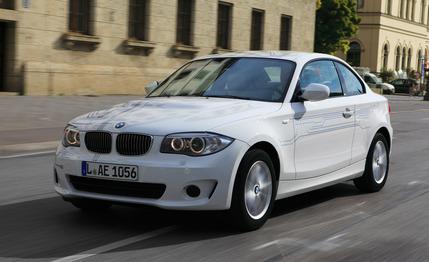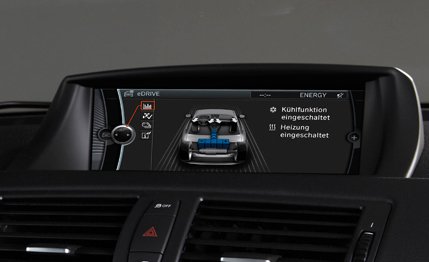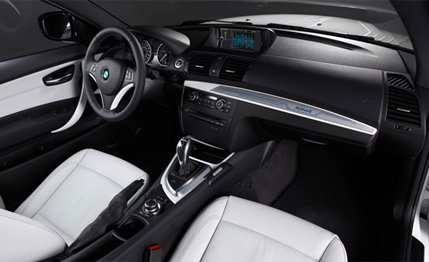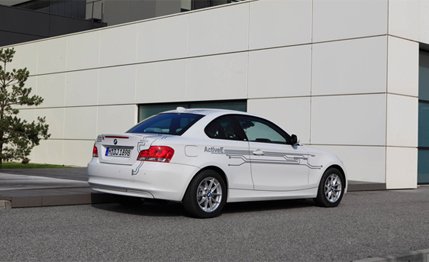
 First Drive Review
First Drive Review
We get a lot of reader mail every month. Whereas “You’re idiots for not picking the same car I would have chosen in that comparo,” “You’re on Hummer’s [or some other car company’s] payroll,” and “Dude, sweet hair,” are the most common messages, we also hear occasional chiding for using both “engine” and “motor” to describe the internal-combustion devices that power cars.
After driving BMW’s new 1-series-coupe-based ActiveE, we can say we’re not the only ones to do so. To get going in this pretty standard-looking 1-series—well, aside from the circuit-board exterior graphics—you have to push a button that, just as in a gas-fired 1-series, is labeled “Engine Start.”
Start What?
The thing is, the ActiveE doesn’t have an engine. As readers love to point out, it has a motor. Where once there was an engine there’s now a huge battery pack about the size of a piece of luggage you’d try to carry on and fail to fit into the overhead bin. Protected in frontal collisions by sturdy bracing that takes up roughly the front half of the engine compartment, the underhood pack is one of three in the ActiveE. BMW’s description of batteries being located underhood, in the transmission tunnel, and in the space vacated by the fuel tank had us imagining lithium-ion cells squishing out of the car like marshmallow between the grahams in a terminally overstuffed s’more. Not true. The rear pack takes up a mere portion of the fuel tank’s former dwelling, and the trans-tunnel bundle is tucked neatly above a flat tray that covers most of the car’s undercarriage.


Together, the liquid-cooled cells can store 32 kWh of energy. On a 12-amp, 230-volt source (we drove the car in Europe, where 230 is the standard), the pack needs 10 to 12 hours to fully charge. Find a 32-amp source, and that time drops to four or five hours. BMW provided no charge times using 120 volts, but we can tell you from experience with our long-term Nissan Leaf that you won’t want to rely on a toaster circuit to charge your car. We’re not even going to bother telling you that the range according to the spectacularly unrealistic European combined driving cycle is 127 miles—okay, we told you anyway—instead preferring BMW’s estimate, which says that customers should achieve something more like 100.
The low mounting of the underfloor battery helps keep the ActiveE’s center of gravity at effectively the same height as that of a gas-powered 1-series. Additionally, positioning the front pack farther back in the engine bay and hanging the rear one at the extreme back of the car means that this electric car carries half its total weight on each axle. But of course it does. BMW is pretty obsessive about that.
It’s Notah Motah (Uh, Yeah, It Is)
The engine—er, motor—is at the rear axle, which it drives through a one-speed gear-reduction transmission. The controlling electronics perch on top of the motor, and the resulting bundle juts into the trunk and reduces capacity from 10 cubic feet to 7. Golfers rejoice: The hump is offset to the passenger side, leaving the left-side pass-through usable for a bag of clubs.
BMW outsourced the drivetrain in its last electric experiment, the MiniE, but the ActiveE’s was developed in-house. Aside from consolidating the batteries into a single pack—and anything else BMW thinks it needs to change following its ActiveE experience—it’s largely what you’re going to see in the upcoming purpose-built i3 electric car. That bodes well for the i3, particularly since it will cart around some 1300 fewer pounds. The ActiveE is a porker: At an estimated 4050 pounds, it weighs nearly 700 more than the last 135i we tested.


To help you make your tee time when golf Saturday starts out with a pounding hangover and a detour for pancakes, though, the electric motor makes a maximum of 168 hp. Being an electric motor, every last drop of its 184 lb-ft of torque is available from 0 rpm, and BMW says the car should hit 60 mph in about nine seconds. Top speed is governed at 90 mph.
Thanks to the immediate rush of torque, the ActiveE pops off the line quickly enough for the car’s intended commuting duties, although the single gear ratio means that acceleration tapers off quickly above 35 or so mph. Whine from the electric motor is more audible under load than it was in our Leaf, which might disappoint some greenies. On the other hand, EV-driving enthusiasts—surely at least two exist to form a plurality—will probably dig a little aggression mixed into their earth-saving mission. In any case, the noise is minimally intrusive, and no more so than a gas engine’s. At a constant speed, the motor fades into the background completely, and the ActiveE was literally whisper quiet inside while traveling at its 90-mph maximum speed on the autobahn.
Slow Dance
In the ActiveE, drivers quickly acclimate to using the rightmost pedal as an accelerator and as a sort of brake pedal in reverse, as less pressure results in greater deceleration from the regenerative braking system. In traffic, this BMW is a one-pedal car, drawing itself to a stop aggressively enough that we rarely used the brake. There is a learning curve, but it’s shallow. An “eco pro” mode is activated by pushing a button aft of the shifter; it softens the throttle and limits the draw of the climate control, heated seats, rear defroster, and other accessories. It doesn’t numb accelerator response to the extent that a similar mode in the Leaf does—the Nissan’s go pedal can be rendered so unresponsive as to be potentially dangerous—and the difference between normal operation and eco pro is nearly imperceptible. We didn’t use the mode much.
And so there’s remarkably little to cue drivers to the fact that the ActiveE isn’t just a slow 1-series. (Except those graphics. The company will strip the vinyl circuitry at no charge, though, to fully expose the white paint. There are no other colors available.) The steering—electrically boosted as in European 1-series models, instead of the hydraulic setup we get in the States—has excellent weighting. There’s a little dead spot on-center, but the system is otherwise very responsive. Try as we might, we couldn’t do any EV drifting with this car, though, as it is a devoted understeerer.
BMW will start delivering the ActiveE yet in 2011. It will produce 1100 cars, 700 of which are earmarked for the U.S., and former lessees of the MiniE get first dibs. The Mini program, originally intended to last one year, was extended a year and then another six months on top of that to accommodate customers who desired a seamless transition from electric Mini to electric BMW. We imagine many of those who enjoyed their MiniE will do just that—at $2250 down and $499 a month for two years, the ActiveE will command a few grand less than the Mini. (That car started at $850 a month in the first year and then cost $600 per month for the second year; there was no down payment.) Additionally, BMW has timed the end of the ActiveE lease period to coincide with the introduction of the i3, potentially allowing customers a solid four-year lead-in to a full-production electric BMW product. As good as the ActiveE is in delivering a fairly seamless electrified experience—except for the limited range—it only increases our expectations for the far lighter i3. Ladies and gentlemen, start your engines!

